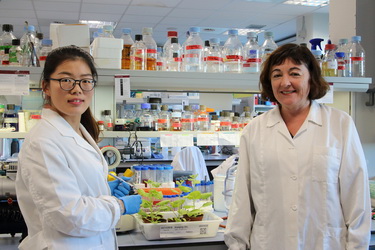
Plants as Antifungal Factories
December 12, 2018| |

Maria Coca, a researcher at CRAG and one of the senior authors of the study, explains that only a few classes of antifungal agents are available today. She adds that these are not fully effective due to the development of resistance, host toxicity, and undesirable side effects. Many of these compounds cannot be used because they do not comply with the regulations. Thus, there is an urgent need to develop novel antifungals which can be applied in diverse fields, including crop and postharvest protection, preservation in cosmetics, materials and food, and animal and human health.
Through genetic engineering, CSIC researcher José Antonio Daros and his team modified the tobacco mosaic virus (TMV) so that, instead of producing its own pathogenic proteins, it produced other proteins of interest. Coca's team then implemented this tool to produce antifungal proteins in leaves of the Nicotiana benthamiana plant and discovered that these leaves produced large quantities of these new antifungals. The researchers also showed that extracts from the N. benthamiana plants are active against pathogenic fungi and could protect tomato plants from the fungus Botrytis cinerea, better known as gray mold.
For more details, read the news release from CRAG.
| |
Biotech Updates is a weekly newsletter of ISAAA, a not-for-profit organization. It is distributed for free to over 22,000 subscribers worldwide to inform them about the key developments in biosciences, especially in biotechnology. Your support will help us in our mission to feed the world with knowledge. You can help by donating as little as $10.
-
See more articles:
-
News from Around the World
- Nobel Laureates: Fear of GM Crops Prevents Society from Benefiting from the Technology
- WRI Report Says GMOs and Gene Editing Can Help Improve Crop Breeding to Boost Yields to Feed the World
- Alliance for Science Ghana Calls for Passage of Plant Breeders' Bill into Law
- USDA to Release Final ‘Bioengineered' Food Labeling Standard
- Report Highlights USDA Technology Innovations
- Biotech Cotton in Pakistan Reached Highest Adoption in 2017
- OECD Study Provides New and Detailed Evidence on Market Concentration in Seed and GM Technology
- Aarhus University Researchers Release New Insights in Rust Resistance in Wheat
- Plants as Antifungal Factories
-
Research Highlights
- Transgenic Pm3e Wheat Show High Resistance to Powdery Mildew
- International Research Team Finds Novel Function of Plant Hormone Jasmonic Acid
-
Announcements
- International Conference on Microbes for Sustainable Agriculture
-
Resources
- Updated ISAAA Infographics: Do you know where biotech crops are grown?
-
Plant
- Researchers Discover Mechanism Disrupting CRISPR-Cas9
- CRISPR-Cas9 Reveals Role of SlPHO1;1 in Phosphate Nutrition of Tomato Seedlings
-
Read the latest: - Biotech Updates (December 17, 2025)
- Gene Editing Supplement (December 17, 2025)
- Gene Drive Supplement (February 22, 2023)
-
Subscribe to BU: - Share
- Tweet
